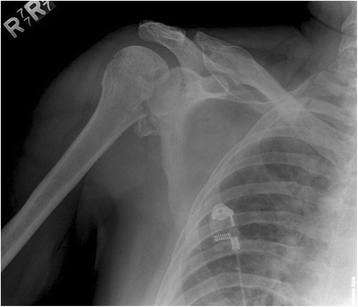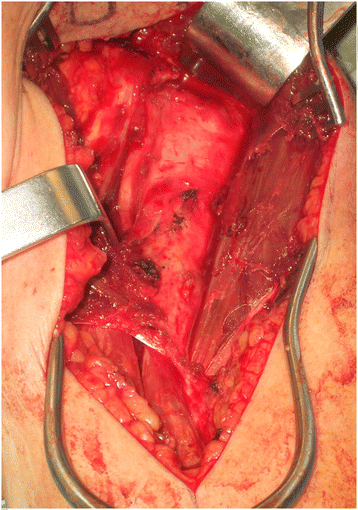Proximal humerus derotational osteotomy for internal rotation instability after locked posterior shoulder dislocation: early experience in four patients
- PMID: 25954319
- PMCID: PMC4423112
- DOI: 10.1186/s13037-015-0062-9
Proximal humerus derotational osteotomy for internal rotation instability after locked posterior shoulder dislocation: early experience in four patients
Abstract
Background: We performed a retrospective and descriptive study to determine the feasibility of proximal humerus derotational osteotomy in younger patients with significant humeral head depression, who may not be good candidates for shoulder arthroplasty.
Methods: Rotational osteotomy was done on four patients with a mean age of 40 for locked posterior dislocation associated with a reverse Hill-Sachs lesion from 2000-2011. The average age was 40 +/- 11 years old and the average follow up was 22 +/- 8 months. Shoulder stability, range of motion, radiographic outcome and postoperative complications were assessed. Average follow-up was 22 months (range, 12-30 months) postoperatively.
Results: The average range of motion of the shoulders at the final follow-up were as follows (Mean +/- Standard deviation): Abduction: 125 +/- 29°, Forward flexion: 135 +/- 17°, Internal rotation: 65 +/- 17°, External rotation: 62 +/- 10°. There were no wound or neurological complications and no dislocations. Patients were satisfied with their functional status and did not have any further symptoms of instability or rotator cuff dysfunction.
Conclusions: Proximal humerus derotational osteotomy for acute locked posterior dislocation of the shoulder can be a viable option for younger age group, which can facilitate rehabilitation for these patients by providing immediate stability.
Keywords: Derotational osteotomy; Hill-Sachs lesion; Humerus.
Figures




Similar articles
-
Humeral head plasty for a chronic locked anterior shoulder dislocation.Orthopedics. 2009 Jan;32(1):52. doi: 10.3928/01477447-20090101-15. Orthopedics. 2009. PMID: 19226030
-
Transfer of the lesser tuberosity for reverse Hill-Sachs lesions after neglected posterior dislocations of the shoulder: A retrospective clinical study of 13 cases.Acta Orthop Traumatol Turc. 2017 Oct;51(5):362-366. doi: 10.1016/j.aott.2017.07.004. Epub 2017 Aug 26. Acta Orthop Traumatol Turc. 2017. PMID: 28844682 Free PMC article.
-
Rotational humeral osteotomy for recurrent anterior dislocation of the shoulder associated with a large Hill-Sachs lesion.J Bone Joint Surg Am. 1984 Dec;66(9):1443-50. J Bone Joint Surg Am. 1984. PMID: 6501339
-
[External rotation osteotomy of the humerus for the treatment of shoulder problems secondary to obstetric brachial plexus palsy].Acta Orthop Traumatol Turc. 2005;39(4):328-33. Acta Orthop Traumatol Turc. 2005. PMID: 16269880 Turkish.
-
Clinical and radiographic outcomes of the modified McLaughlin procedure for locked posterior dislocation of the shoulder: a systematic review.JSES Rev Rep Tech. 2023 Oct 5;4(1):8-14. doi: 10.1016/j.xrrt.2023.08.007. eCollection 2024 Feb. JSES Rev Rep Tech. 2023. PMID: 38323196 Free PMC article. Review.
Cited by
-
Posterior Shoulder Instability and Glenoid Bone Loss: A Review and a Free Bone Graft Technique.J Clin Med. 2024 Mar 30;13(7):2016. doi: 10.3390/jcm13072016. J Clin Med. 2024. PMID: 38610781 Free PMC article. Review.
-
The "BioHumi" Humeral Head Osteochondral Allograft Transplantation for Reverse Hill-Sachs Lesion of the Shoulder.Arthrosc Tech. 2022 Dec 21;12(1):e107-e114. doi: 10.1016/j.eats.2022.08.065. eCollection 2023 Jan. Arthrosc Tech. 2022. PMID: 36814973 Free PMC article.
-
The clinical and functional outcomes of closed reduction and arthroscopic McLaughlin procedure in patients with neglected locked posterior shoulder dislocation.SICOT J. 2024;10:53. doi: 10.1051/sicotj/2024050. Epub 2024 Dec 3. SICOT J. 2024. PMID: 39625217 Free PMC article.
-
Posterior shoulder fracture-dislocation: an update with treatment algorithm.Eur J Orthop Surg Traumatol. 2017 Apr;27(3):285-294. doi: 10.1007/s00590-016-1840-5. Epub 2016 Aug 25. Eur J Orthop Surg Traumatol. 2017. PMID: 27562590 Review.
-
Treatment options for locked posterior shoulder dislocations and clinical outcomes.EFORT Open Rev. 2019 May 11;4(5):194-200. doi: 10.1302/2058-5241.4.180043. eCollection 2019 May. EFORT Open Rev. 2019. PMID: 31191987 Free PMC article. Review.
References
-
- Kronberg M, Brostrom LA. Rotation osteotomy of the proximal humerus to stabilise the shoulder. Five years’ experience. J Bone Joint Surg (Br) 1995;77(6):924–7. - PubMed
-
- Finkelstein JA, Waddell JP, O’Driscoll SW, Vincent G. Acute posterior fracture dislocations of the shoulder treated with the Neer modification of the McLaughlin procedure. J Orthop Trauma. 1995;9(3):190–3. - PubMed
-
- Ponce B, Millett P, Warner J. Management of Posterior Glenohumeral Instability With Large Humeral Head Defects. Tech Should Elbow Surg. 2004;5(3):146–56. doi: 10.1097/01.bte.0000130603.30293.3c. - DOI
LinkOut - more resources
Full Text Sources
Other Literature Sources

